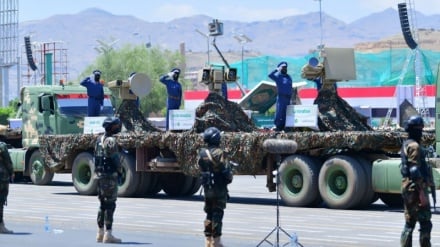Yemen, the 5th year of fire and blood (1)
The Saudi-led war on Yemen entered its fifth year on March 26, 2019. What took place during four years of war against Yemen has been full of war crimes. In a two-part program, we will discuss some of the crimes against Yemen during four years.
Rafael Lemkin used the term genocide for the first time in 1933. Lemkin considered destruction of racial, religious or social groups in terms of international rights as a crime. Lemkin discussed his idea in his book titled "Axis Rule in Occupied Europe" which was published in 1944.
UN Resolution 86(1), ratified on December 11, 1946, is the first document set in the first year of the UN activity on genocide. The resolution has defined genocide as denial of right of existence of all or part of human groups. In this resolution, genocide was defined as a crime, calling on all states to enact a law for prevention and punishment of genocide. According to this resolution, the UN approved "the Convention on Prevention and Punishment of the Crime of Genocide" in 1948. In article 1 of the convention, genocide has been defined as a crime. The article reads, "The Contracting Parties confirm that genocide, whether committed in time of peace or in time of war, is a crime under international law which they undertake to prevent and to punish."
Article 2 of the Convention also states that:
"In the present Convention, genocide means any of the following acts committed with intent to destroy, in whole or in part, a national, ethnical, racial or religious group, as such : Killing members of the group; Causing serious bodily or mental harm to members of the group; Deliberately inflicting on the group conditions of life calculated to bring about its physical destruction in whole or in part; Imposing measures intended to prevent births within the group; Forcibly transferring children of the group to another group."
Prior to the implementation of the Rome Statute of the International Criminal Court in 2002, several specialized courts had been set up regionally and globally. One of the most important crimes in these trials was genocide. For example, the Rwanda International Criminal Court named genocide as "crime of crimes." It is noteworthy that in the Rome Statute, genocide is considered as the prime crime, and the only one that has been accepted by the designers of the statute with no negative vote. Article 6 of the Statute of the International Criminal Court specifies the crime of genocide and its implications are similar to Article 2 of the Convention on the Prevention and Punishment of the Crime of Genocide, adopted in 1948.
Numerous figures and reports from various international institutions indicate that what the Saudi coalition has done in Yemen over the past four years is the embodiment of genocide stipulated in Article 2 of the Convention on the Prevention and Punishment of the Crime of Genocide and Article 6 of the Rome Statute.
For the past 4 years, the Saudi coalition has launched about 20 thousand air raids against Yemeni people. The air raids inflicted many casualties and losses on Yemen. According to the report of the Legal Center for Rights and Development, over the past 4 years, 39,856 Yemenis have been killed and wounded as a result of the Saudi-led attacks. According to this report, 15,504 civilians were killed in the past four years, including 3,767 children, 2,361 women and 9,446 men. Meanwhile, during the past four years, 24,352 people have been injured, including 3,761 children, 2,742 women and 17,849 men. In other words, about one third of casualties are children and women and most of the air raids were launched against civilians. Meanwhile, according to a report from the International Children's Rescue Institute, 85,000 Yemeni children under the age of five have died as a result of bombardments or illness.
In the wake of the all-out blockade by the Saudi regime and its partners-in-crime, Yemen has faced the worst famine in the world in recent decades. The Stockholm talks, which were held under the UN supervision in December 2018, were focused on finding solutions to put an end to this siege. Accordingly, Al-Hodeida port was the main subject of the talks because 70% of Yemen food needs are imported via this port. But the agreements made in Stockholm, including dispatch of humanitarian aid through Al-Hodeida, have not been implemented after more than 4 months due to the Saudi obstructionism. Based on a UN report, 80% of the 24 million Yemeni population including more than 12 million and 300 thousand children are in need of humanitarian aids. The UN Resident Coordinator in Yemen, Lise Grande, said: "More than 10 million Yemenis are just one step away from death, and 7 million people are malnourished." Also according to the report of International Children's Rescue Institute, 2 million children and 46% of the population have no access to hygienic water. Moreover, about half of all children aged 6 months to 5 years face malnutrition. Almost all food sources including markets, farmlands and food imports have been bombed in the past four years. The price of food is so high that most of the Yemenis cannot afford the price.
The cholera outbreak has intensified the deteriorating humanitarian situation in Yemen. According to international organs, Yemen has faced the worst catastrophic events in the world since 1949, with more than one million people prone to cholera only in 2017. This figure decreased at the beginning of 2018, but the disease spread from June 2018 and the third wave of it has started since January 2019. The UN Resident Coordinator in Yemen, Lise Grande, said that cholera has spread all over Yemen and during the past 3 months it has claimed the life of 200 people and over 110 thousand are suffering from this disease which means that the destruction of hospitals and medical centers has seriously aggravated the situation.
In the first two weeks of March, 40,000 Yemeni people have been infected with cholera. According to a report by the International Children's Rescue Institute, the figure has increased by 150% compared to the previous month, while more than a third are children under the age of 15. In other words, nearly 1,000 Yemeni children have suffered from cholera every day. Also during the past 4 years, over 2.5 million Yemenis have lost their homes.
FK/RM/SS


